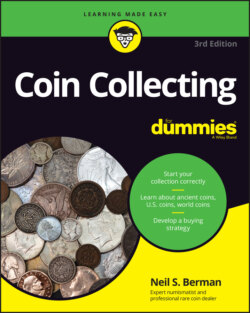Читать книгу Coin Collecting For Dummies - Neil S. Berman - Страница 12
B.C: BEFORE COINS
ОглавлениеBefore the invention of coins, most commerce was done in trade, by bartering. Every time one man wanted to trade the extra goods he had for the goods he needed, he had to set a rate of exchange for every item he traded with every one of his trading partners every time they met. How much cauliflower for how much salt? How many sheep for a cow? What to pay to the chief in return for his protection?
This cumbersome process was probably confusing and time-consuming, and no doubt dreadfully inefficient and very stressful. It probably led to heated arguments and maybe even fights. One man wants to trade a cow for some sheep, but the guy with the sheep wants a horse. The fellow with the food already has water and three daughters, but he’s willing to trade for husbands for his daughters or for wine or axes. But the guy who makes ax heads doesn’t feel well, so there’s a shortage of his fine product. The chief wants his taxes in arrowheads, axes, and knives, probably not daughters. And so it went. Trade, although necessary, was barely productive and definitely not fun.
Out of this carousal of chaos in the barter economy came the first standards of trade. A standard in trade is an item that everyone who trades agrees has a value against which everything else can be judged and then traded. Objects used in this way have included iron bars, seashells (in inland areas where seashells weren’t found), animals, beads, grain, salt, obsidian (volcanic glass), stone arrowheads, and knives, and bone fishhooks. Standards of trade slightly simplified the trading process into a productive and at least somewhat social event.
Next came man's discovery of metal in a natural state. The first of these metals was iron (from meteorites), followed by copper, gold, and silver. These metals were desirable not just because they were great for making tools, but also because of their beauty. Over time, the metals became the most acceptable items for exchange. A man could sell his cow for gold and have something to trade for food the next month. For the most part, these metals were small and convenient to carry and store, making for the first universal medium of exchange.
Still, during each trade, the amount of each metal varied in weight and in pureness. To solve this problem, the natural solution was weighing and marking the value on each piece. Eventually, the local chief took to marking each unit with its value and assigning his mark, indicating its acceptability in trade. Trade expanded to include metal arrowheads, knife blades, and even nails, the direct ancestors of coins as we know them today.
Since the earliest days of coins, tens of thousands of princes, kings, and emperors, as well as an untold number of cities, states, kingdoms, and empires around the world, manufactured coins. Many of them have vanished. But before they disappeared, they minted and issued multiple millions of coins in hundreds of thousands of designs, sizes, denominations, and metals, leaving them for us to find. In fact there are empires that did exist that have only been discovered and identified due to the coinage left behind. The first coin collector undoubtedly appeared along with the first coin. And collecting coins became a social event, as much fun then as it is today.
